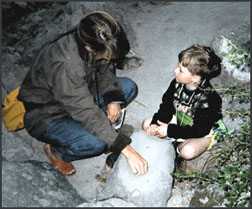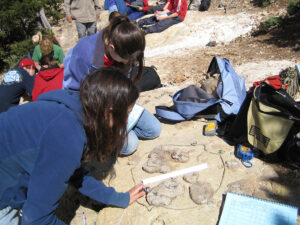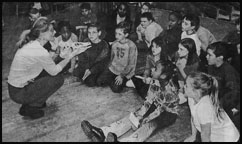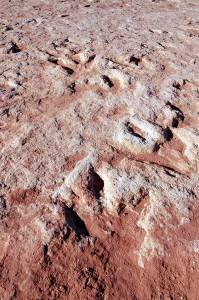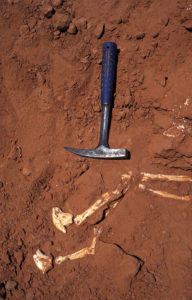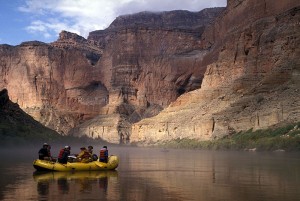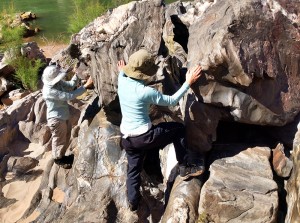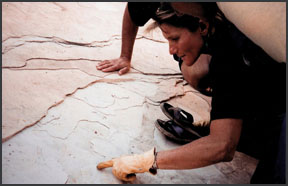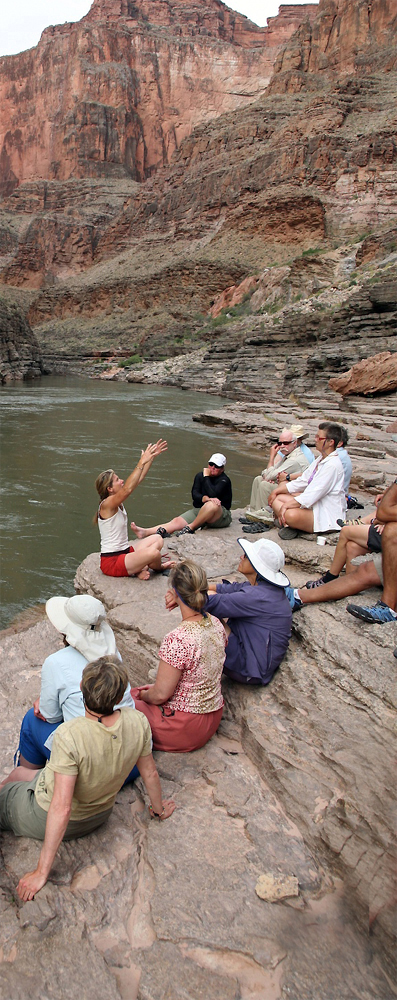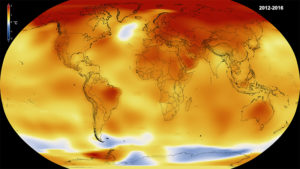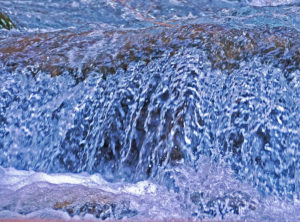The following are only a few sample programs that can be given to students of all ages and background. These will work in various formats, including slide presentations, group discussion, interactive displays and activities, field trips or any combination thereof, depending on the group size and the time available, as well as the subject matter and age of the students involved.
Please note that This Earth can provide programs on any geological or paleontological topic (we’ve done glaciers and groundwater, caves and volcanoes, plate tectonics and geologic time, rocks, minerals and maps, to name a few). This Earth can design short courses and field trips to a school’s or an organization’s specifications, and for K-12 teachers. This Earth programs can be designed to fit state educational standards. Please contact me for details.
GROUP SIZE
The optimal group size for any hands-on and interactive program is around 20 students, although arrangements can be made for larger groups. Slide presentations can be made to groups of any size, from five to 500, and more.
TIME REQUIREMENTS
The minimum amount of time required for each program is listed following the name of the program.
In all cases, This Earth programs are related as much as possible to the geology of the local area, so that students begin to understand their own region’s history and stories as well as the larger story of the Earth.
- Slides, interactive fossil exercise, discussion, field trip, grades K and up
- 30 minutes to two hours for classroom activity, half day for field trip (not including travel time). For kindergarten and first grade, this program is modified into about a half-hour time slot where most of the time is spent looking at and touching the fossils.
The last part of the program will involve a discussion about how to use fossils to create a reconstruction of that ancient environment in which that rock layer formed. This is a hands on and interactive program with the students. The fossils will be set up and the students can touch and look at them, pass them around and discuss the questions.
A shorter program follows the same principles, but simplifies the process for the time constraints. If the students can do a field trip and there are fossils nearby, we will use fossils in place in the rock to do this exercise.
- Slides presentation, hands-on interactive exercises, grades three and up
- 30 minutes minimum, one hour with hands-on lab classroom activity, longer if working outdoors
We discuss how to prospect for and find fossils, what one looks for and how to recover them from the ground and prepare them in the lab. A slide presentation can be followed by the chance for students to dig to find their own fossils. This can be accomplished in the classroom or the playground in sandboxes with fossils the students “dig up” on their own, and piece together into an organism, or out in the field where students can find, identify and dig their own fossils (depending on location).
- Slides, interactive exercise, fossils, discussion grades two and up
- 1.5 hours minimum for classroom activity, Two hours for northern Arizona (or other local) field trip (not including travel time)
In this presentation we use a dinosaur track site from northern Arizona to illustrate how tracks can help us learn the size, shape, speed, and posture of an animal. During the program, the students help interpret the behavior of the dinosaur by measuring the tracks, placing them in their proper positions and walking like a dinosaur. Students are also able to interact with fossils to determine other aspects of dinosaur lifestyle such as diet and family behavior. If we are in the classroom, students will use copies of the tracks. If the students have track sites nearby, or can come to the track site in northern Arizona, they will see and measure tracks in place, and use other geological and paleontological clues to help determine the ancient environment.
- Slide presentation and hands-on fossils, discussion, grades four and up
- One-hour minimum classroom presentation.
Students see a paleontological expedition from beginning to end as it travels through the Gobi Desert in Mongolia. We discuss preparations for such field work, equipment and supplies, and meet the team. The trip takes us across one of the remotest regions on Earth, to find some of the more spectacular fossils known. The dinosaur and mammal fossils collected from one special location in the Gobi are changing the way paleontologists think about dinosaurs, their social behavior and relationships with other animals.
- Slide and video presentation, grades four and up
- One-hour minimum classroom presentation.
This slide presentation takes us on a river trip through the Grand Canyon. Along the way, we learn about life on the river and how to navigate rapids and read the water, as well as exploring the geologic story visible in the rocks of the canyon walls. This presentation can be combined with exercises in fossils, rocks, geologic time, plate tectonics, or map reading depending on time constraints and the needs of the group.
- Slides and discussion, grades six and up
- One-hour minimum classroom presentation, full day with field trip.
In this class, we discuss the relevance of geology to our everyday lives, using media reports of geological happenings around the world, and visits to places in town or nearby that can be explained using basic geologic principles. From tsunamis and earthquakes to simple soil creep and crumbling sidewalks, this class will help students and teachers understand how geology can be applicable to their lives.
- Slide and map presentation and field trips, grades four and up
- One-hour minimum classroom presentation
In these presentations we discuss the geologic history of your particular region of interest. We discuss the geologic evidence and how to read it, as well as tell the story of the region from its beginnings to the present day, including the history of life and the processes that have shaped the land to make it look the way it does today.
- Slide presentation, discussion and hand-on activities for teachers
- Two-hour minimum presentation (preferably longer)
This workshop discusses methods and techniques to make Earth sciences more accessible to your students. Using a combination of discussion and activity, we explore the issues and problems with teaching Earth sciences, what works and what doesn’t, and talk about potential problems and solutions.
- Discussion and practice sessions for outdoor professionals who lead the public into wilderness settings
- Two-hour minimum discussion (preferably longer); can be offered as several day workshop for an organization or in conjunction with a college course.
This workshop focuses on how to interpret the Earth sciences to wilderness travelers in a professional guiding situation. An important portion of any wilderness expedition is interpreting the landscape for your travelers. It can be intimidating to try and interpret Earth science concepts to travelers in a way that is interesting and applicable. In this workshop we discuss problems and techniques. In longer workshops, participants will give practice talks and critique style and technique. If possible, we’ll get outdoors and use the landscape around us for practice.
Powerpoint, interactive exercise and discussion for grades 6 and up.
1.5 hours minimum.
In this presentation, we learn about the Earth’s weather and climate in a geological and historical context. We discuss the difference between weather and climate, and look at how Earth’s climate has changed over time. We also discuss the evidence that leads scientists to conclude that anthropogenic climate change is occurring, and some of the things that individuals, companies, and communities around the world are doing to mitigate the effects of climate change. As a group, we discuss ways to talk to other people about climate change and how to help people understand the major issues.
Powerpoint, interactive exercise and discussion for grades 6 and up. Field trip to a local river, lake, or pond if possible.
1.5 hours minimum, full day if including a field trip.
Water has become a major issue worldwide, and yet very few people understand where their water comes from, and how important it is to every aspect of life on Earth. We discuss the hydrologic cycle and the concept of watersheds, with an emphasis on the local watersheds of the area we are in. We’ll also discuss some of the ideas that have been proposed for dealing with water shortages and water use. If possible, we will take a field trip to a local river, stream, or lake to put some of what we have discussed in context.
